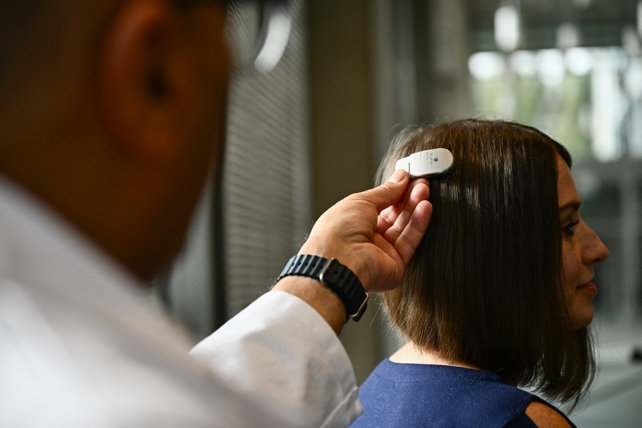Amber Pearson, a 34-year-old American, struggled with obsessive compulsive disorder (OCD) that led her to frequently wash her hands until they bled due to her fear of contamination. However, a revolutionary brain implant has significantly alleviated the repetitive rituals of her condition, providing her with relief from both her OCD and epilepsy. Thanks to this breakthrough treatment, she can now engage fully in her daily life and has found freedom from her obsessive worries. Dr. Ahmed Raslan, a professor of neurological surgery, demonstrating the placement of the brain implant. (Patrick T. Fallon/AFP)Brain implants have been making headlines lately, notably with Elon Musk’s Neuralink company achieving a significant milestone by placing a chip in a patient’s head. This breakthrough has the potential to eventually enable individuals to control a smartphone using only their thoughts. The concept of implanting a device into the brain is not novel, as doctors have long been aware that precisely applied electrical stimulation can impact the brain’s functioning. Deep-brain stimulation has been successfully used in treating Parkinson’s disease and other movement-related conditions, including epilepsy. Pearson’s doctors offered her a 32-millimeter (just over an inch-long) device to address her debilitating epileptic seizures, confident that it could detect the activity triggering the episodes and administer a pulse to intervene effectively. It was during this process that Pearson had a revelation and suggested incorporating treatment for her OCD in the implantation procedure. This idea was taken seriously and led to a significant breakthrough in her treatment plan.
Dr. Ahmed Raslan, a professor of neurological surgery, demonstrating the placement of the brain implant. (Patrick T. Fallon/AFP)Brain implants have been making headlines lately, notably with Elon Musk’s Neuralink company achieving a significant milestone by placing a chip in a patient’s head. This breakthrough has the potential to eventually enable individuals to control a smartphone using only their thoughts. The concept of implanting a device into the brain is not novel, as doctors have long been aware that precisely applied electrical stimulation can impact the brain’s functioning. Deep-brain stimulation has been successfully used in treating Parkinson’s disease and other movement-related conditions, including epilepsy. Pearson’s doctors offered her a 32-millimeter (just over an inch-long) device to address her debilitating epileptic seizures, confident that it could detect the activity triggering the episodes and administer a pulse to intervene effectively. It was during this process that Pearson had a revelation and suggested incorporating treatment for her OCD in the implantation procedure. This idea was taken seriously and led to a significant breakthrough in her treatment plan.
US Woman Gets Innovative Brain Implant for OCD And Epilepsy














